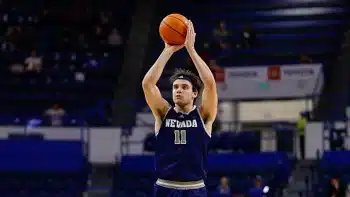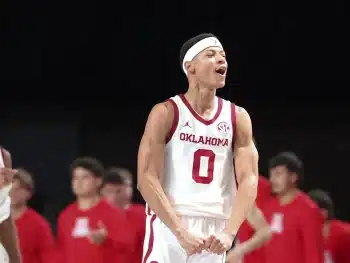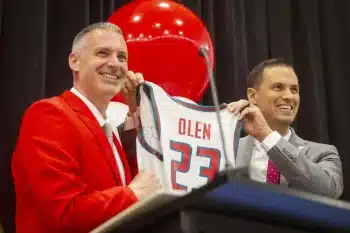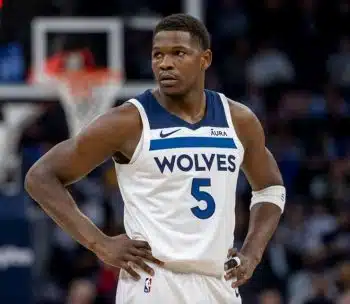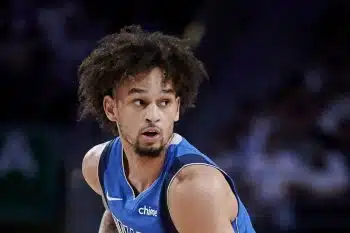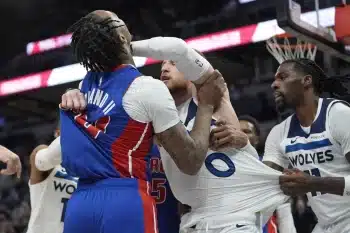NBA
NBA AM: Who Still Has Cap Space?
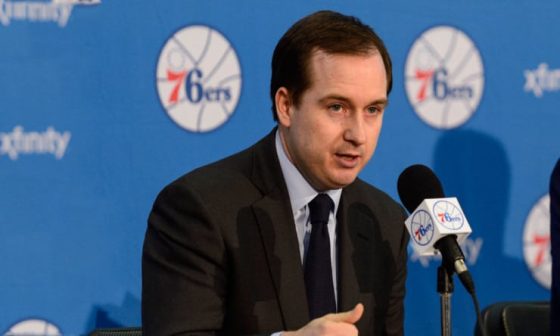
Who Can Still Play In Free Agency?: While the bulk of the deals have been finalized, there are still a few NBA teams with salary cap room to play with. Here is who has cap cash left:
Portland Trail Blazers – $19,477,606 Under The Cap
The Blazers currently have the most available cap room of any team in the NBA and have 17 players currently on the roster. There is a good chance that swingman Mike Miller will be bought out at some point, and the Blazers do hold three players with non-guaranteed deals.
There is no question that when LaMarcus Aldridge opted to leave in free agency things changed. As Blazers GM Neil Olshey has explained a few times, the plan in Portland is to surround Damian Lillard with players in his age range so that they can grow into something together, and most of the team’s free agent moves and trades have lined up with that.
With so much cash left to spend, the Blazers can leverage that space to extract assets, much like they did with Cleveland and the Brendan Haywood contract. It’s unlikely the Blazers throw cash at anyone left in the market place, but if a large salary guy becomes available in trade the Blazers have the resources to make a deal.
Cap space is a commodity and, as the Philadelphia 76ers have proven for the last two years, having room to park a contract can help you collect a lot of assets. That seems to be the Blazers’ plan for the immediate future.
Philadelphia 76ers – $13,907,212 Under The Cap
The 76ers come in second to the Blazers, and surprisingly they may use some of it for an offer sheet on restricted free agent Norris Cole. The 76ers’ plan for the last two years was to amass assets and talent, and this year seems to be the year they plan to put that talent on the floor and try and compete.
The 76ers have made leveraging cap space into assets an art form, so even if New Orleans opts to match an offer sheet on Cole (which is still in discussion), the 76ers will continue to work the field as long as they have room to do it.
Playing the cap game as Philadelphia has done isn’t overly sexy, but when you look at what they were able to extract in payments for parking players on their cap, they have done as good a job as anyone in the NBA at stocking up the cupboard. If Cole doesn’t pan out, you can expect more of it, as this may be the last year where that tactic yields fruit.
Utah Jazz – $6,738,065 Under The Cap
The Jazz have some real cap space available, but it’s unlikely they are going to use much of it. With 17 players under contract and 13 fully guaranteed deals, there isn’t much room on the roster for more guys.
While improving and competing for a playoff berth is something the Jazz are expecting this year, there is a belief that the biggest gains will come from internal growth not external additions.
Having space is always a good thing, especially when the trade market opens up in December, but as things stand the Jazz’s free agency is mostly complete. The question becomes which guys at the end of the roster make the team? There is a real debate on who gets those final roster spots.
Denver Nuggets – $2,643,907 Under The Cap
The Nuggets’ cap number likely goes up if they follow through on waiving Kostas Papanikolaou, who has an October 4 guarantee date on his $4.8 million. The Nuggets have some time to try and re-trade him for an asset, especially for a team trying to shed cap cash or create some roster flexibility.
As things stand in Denver they have 16 roster players including Papanikolaou and a partial guarantee on Erick Green. It’s unlikely that the Nuggets are going to add much more to the roster than they already have and will likely have flexibility around the trade deadline, which could make them buyers, especially if they waive Papanikolaou as expected.
Cap flexibility in and of itself is an asset, especially for a Nuggets team that’s always mindful of cash flow.
Orlando Magic – $1,889,998 Under The Cap
The Magic have a little bit of breathing room under the cap, but not enough to make a splashy move. The more likely scenario is Orlando uses some of the cash to guarantee some money to camp invites with the intention of stashing them in the D-League like they did a last year with Seth Curry, Peyton Siva and Kadeem Batts.
The Magic currently have 14 players under contract not including second rounder Tyler Harvey or guard Keith Appling who they were reported to have reached a contract with, so there isn’t much room on the roster for more.
The Magic could trigger a trade or two to open up spots, but the general belief is this is the group that’s going to open the season. How the parts fit together will tell if it stays that way throughout the season.
While the number of teams with space is fairly small, the number of teams staring at the luxury tax is significantly bigger; here is what to watch for with each:
Oklahoma City Thunder – $12,417,411 Over The Tax
As things stand today, the Thunder are over the cap more than any other team in the NBA. That’s a little surprising considering how many assets the team has given up over the last few years to stay under the tax line, but it’s clear that the Thunder are all the way in on this roster.
All 15 roster spots have a guaranteed salary, so there won’t be any relief or reductions via camp cuts.
There are a couple of contracts that could be movable to reduce the tax bill, but in talking with sources close to the Thunder there isn’t a lot urgency to cut cost and there is a belief it’s now or never with this roster. Given the looming free agency of star Kevin Durant and Russell Westbrook’s future not that far behind, this is the window the Thunder have been waiting for and they are ready to spend to prove it.
Now if the injury bug resurfaces or the parts just don’t fit under new head coach Billy Donovan, things could change but it’s more likely than not that the Thunder stay where they are which means a tax bill of more than $22.293 million, when you factor in the gradually increasing tax penalty on over spending.
Los Angeles Clippers – $10,765,710 Over The Tax
Given how little the Clippers had to work with this summer in terms of cap space, they did a great job re-tooling their roster. There is almost no scenario in which the Clippers are not tax payers, and given the moves they have made they are fairly locked into this current roster.
The lone exception might be swingman Jamal Crawford. With the arrival of Lance Stephenson and the re-signing of Austin Rivers, it’s unclear how big a role Crawford will play. This one could go both ways, moving off his $5.675 million contract might return a decent lower priced player and reduce the tax bill a little. But given how quickly the Clippers ran out of gas in the postseason, hanging on to Crawford for the playoffs might make more sense.
It’s unlikely the Clippers do anything before training camp; if Crawford gets traded its likely because guys like Stephenson and Rivers live up to expectations making Crawford expendable.
Golden State Warriors – $10,747,927 Over The Tax
The Warriors look fairly locked into their tax overage, as there really isn’t any combination of players that could be offloaded to clean up their books. The Warriors recently flipped Gerald Wallace for Jason Thompson to reduce their tax burden, and there may be one more smaller move to get the number lower as the season goes on, but this seems like the roster the Warriors are bringing to camp.
A little luxury tax is a small price to pay for a NBA championship, and if healthy it’s hard to imagine the Warriors won’t be in the hunt for a repeat.
Cleveland Cavaliers – $10,668,795 Over The Tax
The Cavaliers will be monster tax payers, the question becomes how much will they ultimately pay? There are still two roster spots under negotiation, the biggest being restricted free agent Tristan Thompson. Word is the two sides are still having on-going conversations but the gap between what was originally agreed to be workable – five years, $80 million – seems to have been tabled after others in the free agent class received more. The problem with more for the Cavaliers is that every extra dollar given to Thompson gets taxed at a much higher tax rate. For example, Thompson’s $6.77 million qualifying offer costs the Cavaliers $12.085 million in new tax. If Thompson signs a deal at $13 million, the tax cost jumps to $29.05 million, and that’s just the cost of Thompson. Not the other $88.63 million owed to the rest of the roster or the $5.83 million in tax they owe to that spending.
While having Thompson pick up the qualifying offer is risky, as it would make him an unrestricted free agent next summer, is he really worth more than $13 million in salary and $29.05 million in tax? Next summer when the tax ceiling rises tremendously, fitting a big deal for Thompson likely makes more financial sense even if it means bidding against a much higher salary cap environment. Waiting could shift more of that expense into Thompson’s pocket.
The sense from the Cavs is either they’ll do a deal in the $80 million range, or Thompson plays out his qualifying offer; there seems to be almost no interest is trying to solicit an offer sheet from another team.
The last chip for the Cavaliers is guard J.R. Smith. Sources close to the situation say the value of his deal will be based on how much the team has to pay Thompson, but there continues to be a sense that Smith will be back with the Cavaliers and that he’s not overly interested in other situations. Given the Cavs’ tax situation, it’s hard to imagine they offer a ton to Smith in a new deal.
Miami HEAT – $7,133,745 Over The Tax
Not only are the Miami HEAT $7.133 million over the tax, they also qualify as “repeater” tax payers which almost doubles their tax penalty. To put that into perspective, the HEAT’s current tax bill as a “repeater” is $18.367 million. That’s not an insignificant number. The HEAT have been linked to situations involving forward Chris Andersen, who is poised to make $5 million this season. Point guard Mario Chalmers has also been talked about as a trade candidate; he is set to make $4.3 million.
The problem with moving money and not taking any in return is it usually costs draft picks and young talent, something the HEAT don’t really have to spare. Luol Deng’s $10.151 million ending deal could become a reasonable trade chip, especially closer to the trade deadline when the HEAT has paid the bulk of the salary.
The HEAT have ways to reduce their tax bill, and it seems likely they will do that as the trade deadline gets closer, but their message is that if healthy, they believe they are a contender and want to see if that’s true before making any more cost cutting trades.
Chicago Bulls – $4,284,375 Over The Tax
The Bulls as a franchise have been somewhat resistant to paying the luxury tax which puts their current $4.28 million overage on center stage. Combine the pending tax burden with a log jam in the front court and the proverbial clock seems to be ticking on Bulls forward Taj Gibson. Long considered the odd man out, the Bulls have until the trade deadline to reduce their tax bill and moving off most of Gibson’s $8.5 million salary would get it done in one transaction.
Sources close to the Bulls say there have been no decisions made on anyone’s future as they want to bring everyone to camp and see who really fits in new head coach Fred Hoiberg’s system. But with rookie Bobby Portis and second year scorer Doug McDermott expected to see more minutes, someone may not play the role equal to their salary and the Bulls do not like to pay the tax.
San Antonio Spurs – $2,331,718 Over The Tax
Considering the offseason the Spurs had, it’s amazing they were able to work the cap rules as they did to not only land LaMarcus Aldridge but get the bulk of their guys re-signed and stay relatively close to the luxury tax line. There isn’t a single non-role player that could clean up the projected $2.331 million tax overage, although Patty Mills’ $3.578 million could do it and then some. The guy to watch is Kyle Anderson; while the cap value of Anderson is only $1.142 million, combined with partially guaranteed guys like Jimmer Fredette, he could get the bill significantly lower if neither finds a role in training camp.
Houston Rockets – $493,113 Over The Tax
The Rockets are over the tax line with all fully guaranteed contracts so there is no room for relief in partially guaranteed players. What’s worse is the Rockets are only carrying 12 players at this point so the odds are pretty strong that Houston will add to their tax bill before it’s said and done. Being over the tax in a minor way isn’t a terrible thing, but it does restrict what a team can to in trade construction.
If the Rockets wanted to get out from under the tax line, they do have guys like Terrence Jones and Donatas Motiejunas that could clean up the cap and return reasonable assets. With both headed into restricted free agency next summer, those might be the names to watch.
Brooklyn Nets – $184,480 Over The Tax
The Nets get under the tax line after training camp. The Nets have five players on partially guaranteed deals, and cutting almost any of them in camp gets them below the tax line, so it’s highly unlikely Brooklyn faces the tax this year. Considering where they were two seasons ago, that’s pretty impressive cap work.
More Twitter: Make sure you are following all of our guys on Twitter to ensure you are getting the very latest from our team: @stevekylerNBA, @AlexKennedyNBA, @LangGreene, @EricPincus, @joelbrigham, @SusanBible @TommyBeer, @JabariDavisNBA , @MokeHamilton , @JCameratoNBA, @iamdpick, @jblancartenba and @CodyTaylorNBA .
